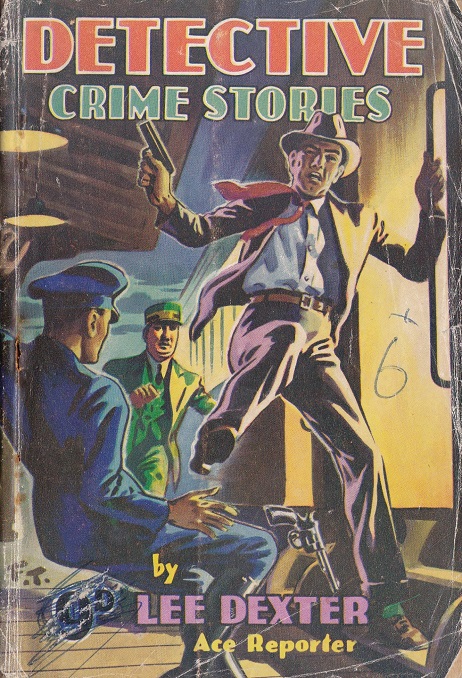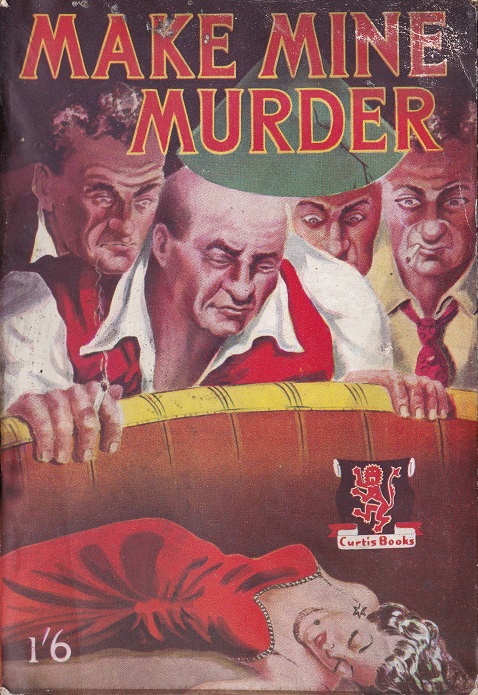STAG: The Magazine for Men (No. 9) was published by Winter Bros. Press Ltd. and is undated; the contents suggest late 1948. It was also the last issue published by Winter Bros.
- Bevis Winter (Editor) Brett Ogilvie (Associate Editor)
- Hervey Elliot Scott (Art Editor) Bill Murray (Supplement)
- W. E. Cade (Advertising) Guy Francis (Research)
As with the prior issues, this contains stock-photos of Hollywood actresses in various poses.
- Cover – Jean Porter
- Page 16 – Betty Hutton
- Page 21 – Penny Edwards
- Page 22 – Linda Darnell
- Page 47 – Julie London
- Page 53 – Ida Lupino
- Page 54 – unnamed
Pages 27 to 40 concern the Football betting pools for the 1948-1949 season, and is edited by Bill Murray, with supplemental articles supplied by Clifford Regan, Ivor N. Bailey, Murray Williams (which sounds mysteriously like Bill Murray), Bruce Morgan, Wilmer Ray, Ness Hall, Wyn Moore, etc. Page 27 introduces Bill Murray and his credentials, while Page 30 supplies biographic information about Regan, Bailey, and Moore.
David Gunston supplies a non-fiction article concerning the civil servant.
Unlike the first two issues, this one cuts back on the amount of artwork and fiction. Internal humor art is supplied by James Symington (numerous times), Simon, Slim, A. E. Beard, Jones, C. P. Archer, Javino, and Joe.
The lead story is High-Powered Hell by Brett Ogilvie. This concerns the fictional life of Johnny, growing up as a child, detesting bullies, caged animals, etc. Come World War Two, Johnny is drafted and becomes a pilot. He eventually drops the atom bomb and mentally becomes fractured and destroyed by the fact that he committed mass murder.
Pages 17 through 21 feature “Silly STAG Stories” and are mere vignettes.
Symptoms I Do — Symptoms I Don’t by Bruce Carr concerns a doctor informing the patient that his teeth must be removed. So, the patient takes out his false-teeth and places them upon the table.
Piccadilly Incident, uncredited, involves a rural idiot winning money, brings his kids to the big city, and makes innocent mistakes.
Up the Ladder by Dane Knox features a man who has a certain aspiration but fails his entire life; meanwhile, he becomes a multi-millionaire while pursuing his one aspiration into his elder years, before finally succeeding…winning small change on a betting pool!
Atoms and Eve by Ogden Bushman; one man and one woman survive the apocalypse. They both eventually end up on the same London train. He is reading the recent newspaper edition, and the article notes only two people have survived. Who the hell printed the newspaper, then? No, our author was not concerned with that glaring error. Instead, the girl scoffs, demanding “If we are the only two people in the world, who the hell is driving this train?” Who indeed.
Even a Psychiatrist will Turn is by David Essex, the same person that authored Betrayed (Curtis Warren, 1948) and Retribution (Curtis Warren, 1949). I read and blogged the Betrayed back in 2016. The story involves a father who brings their child to a psychiatrist. Boy is an absolute brat. Doc insists the parents humor their child’s whims. Let me assure you, it involves among other things, the child wanting to eat a worm, then demands his father eats half first, then accuses him of eating his half. Mom discovers hubby wailing hell out of the kid’s backside…and, we return to the psychiatrist again. He informs her that she needs to humor her husband! And so, reluctantly, she does. He discerns that she has been assigned the same diagnosis as the child and plays the same trick on her. He wants a worm. Cooked. She is to eat it first. She cuts it in half. The boy sees what is happening and blurts “Don’t do it, Ma. He’ll say you’ve ate his half!” She hesitates, and the doc comes running in, to save the day, right? No, he arrives in time to suggest mom puts salt on the worm for proper seasoning!
Reuben O’Hara supplies the humorous short Genius Junior, a person that is a certifiable genius and eventually dies. They cut open his skull and discover it is empty, but on further inspection, find that he had more brains in his finger than the rest of his body.
The concluding short tale by Dennis Wynne is What Colour is a Shirt? An unusual tale concerning a fake country called Elpico striving to retain a President. Each are murdered by the secret order of Monarchists after ascending the throne. In desperation, they turn to Manualez. He turns down the offer but is bribed with the most beautiful young lady to marry. He accepts…but on one condition: his acceptance be kept secret until after his marriage. Ironically, he is secretly the Chief Monarchist. He later sneaks out and discusses his plan with the country’s exiled Prince, whose family was banished from power. The Prince declares that Manuelez’s actions are treasonous. He later decides that he wants the girl for himself. He arranges for his Monarchists to pull off a coup. They succeed. He takes the throne. Then he takes the girl. Manualez is not happy, but is threatened with being locked up, so he departs. In walks the girl, Camelia. Prince suggests she marry him or her daddy will boil in oil. She begs that off. So he suggests a hanging. She can’t face her father dangling, throttled by a rope. The Prince offers next to shoot him dead. She mulls this offer. Quick and clean death. Humane. She finally decides that that won’t do. The truth is, she is already married, but dare not confess, lest the Prince murder her husband. So her father may live on the condition of marriage. She marries the Prince. Only, as the festivities transpire, in barges an irate man. He declares that he is her husband. The Prince’s ire is raised, and demands the truth from Camelia. She confesses. Okay, now the Prince orders her father be shot dead immediately. Only, Camelia is perhaps the smartest person present. The Prince can’t order his death: she ordered his release in the name of the Queen! Her father is likely well across the border by now. Furious, the Prince orders her immediate execution. She checks his move again, and I quote: “It’s against the constitution to execute a woman who is going to have a baby.” Her husband asks if he is really about to be a daddy. He is, and she explains to her husband that she had to falsely go through the marital process in order to save her father. Meanwhile, the Prince has left room and a shot is fired. Fearing the worst, all run into the room, expecting to find that he has committed suicide. Indeed, the Prince fired a round from his revolver at his own skull. He turns to the assembled crowd and proclaims that he missed. And thus ends the story. Seriously? I guess we are to assume that she checkmated him at every turn to the point that he was inept at killing his own self.
I would be remiss if I failed to note that the rear cover advertises a 10th proposed issue. That advert features artwork by Denis McLoughlin, and perhaps is not recorded anywhere else. Only, there would be no 10th issue…at least, not one that has surfaced yet.
If anyone owns other issues of Stag Magazine, please do get in touch with me. I’d love to read and record their contents.







